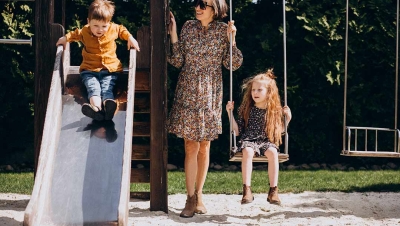We assume that while our children are using playgrounds at schools, recreation programs, and childcare facilities, they are being supervised by trained professionals. Like many other assumptions, this is often incorrect. Teachers, teaching assistants, program leaders, administrators, parents, and other volunteers often have little or no training about playground safety, with the exception of life experience. The unique aspects of playgrounds and high potential for injury make it necessary for playground supervisors to obtain specific training.
It is very difficult to locate playground supervision training programs in academic settings. Few universities offer this type of training in certificate or degree programs. Some training provided through universities includes Playground Maintenance Technician training; University of Technology, Sydney (Playground Safety Training); and the University of Northern Iowa (Certified Early Childhood Playground Inspector and Certified Outdoor School Playground Inspector), which is provided through the National Program of Playground Safety (NPPS). What this may mean to you is that the playground supervisors at the location your child, grandchild, or loved one is playing may not be properly trained.
The majority of playground supervisor training is currently provided by sources outside the educational setting, such as the National Recreation and Park Association Certified Playground Safety Inspector Program, state organizations such as the Texas Recreation and Park Association (TRAPS), and private companies. Our (PlaySafe, LLC) staff members guest lecture at education providers such as the University of New Mexico (to graduate students in the Sport Administration Program Risk Management), high schools, early childhood facilities, and recreation agencies regularly. Having guest speakers visit classrooms to share information is a good start toward educating current and future playground supervisors, however, it is not enough, and more extensive training is needed to insure that teachers, teacher assistants, coaches, caregivers, and other personnel understand playground equipment, hazards, and effective supervision techniques for playgrounds.
A common mistake made by administrators and agencies on playgrounds is an unrealistic ratio of supervisors to students. Scheduling only one teacher to supervise hundreds of students on the playground creates an unsafe environment and is unfair to the supervisor. A study in Iowa cited by the NPPS found ratios of supervisor to children as high as one supervisor to 125 students. One supervisor to 50 students was the most frequent ratio. The College Community School District in Iowa recommends a safe ratio of two supervisors for each grade level on the playground. The appropriate ratio of supervisors to students is determined by the total number of students; age, mental and physical abilities of students; the configuration and type of playground equipment; environmental factors; and emergency procedures. Another common mistake made in terms of playgrounds is making use of volunteers or parents to supervise, without providing any training. Parents were reported as volunteering to be supervisors by 2% of the Iowa survey respondents. Anyone that is assigned to supervise our children should be properly trained.
The days of only stationary metal bars as playground equipment are over. Playground equipment has become more sophisticated, exciting, and challenging. Often the correct and best use of equipment is not apparent. To assure equipment is being used correctly, playground owners should require manufacturers’ representatives to provide on-site training for playground supervisors. Supervisors should understand the intended use and age levels for all the playground equipment.
It is also important for supervisors to have basic knowledge about prevention of injury and removal of hazards that children bring with them to playgrounds. Entanglement hazards like strings on a hood and toys that hang around a child’s neck like binoculars need to be removed prior to the start of play. We teach our children to wear bike helmets on the way to the playground, but children should not wear bicycle helmets on playgrounds. Bike helmets can become caught in openings, resulting in the child’s head becoming entrapped, possibly causing strangulation.
Adequately trained, equipped, and attentive playground supervisors are necessary to protect children. Proactive supervisors enforce rules, make certain that playground elements are used appropriately, prevent unsafe play, and educate children about how to stay safe while on a playground. Research shows that 70% of school injuries take place during recess or physical education classes. A major contributing factor to over 40% of playground injuries is lack of proper supervision (Peaceful Playgrounds, 2014).
In addition to training about specific playground equipment, behavior, clothing, and apparel, supervisors need training about legal concepts. Playground supervisors have a duty to act; a breach of that duty that is the proximate cause of injury or damage constitutes negligence. Supervisors who understand their legal duty to care for children, supervisory actions that can help prevent injuries, and the causes of playground injuries will be more effective. Knowledge of the standard of care (reasonable, prudent person standard), and foreseeability (reasonable anticipation that behaviors or situations could result in injury if not stopped) will also increase the effectiveness of playground supervisors.
Just because someone has a degree in the field of Recreation, Early Childhood Education, Physical Education, or any other Health and Wellness program does not mean that they have been properly trained on playground supervision. Additional training needs to be made available to the people watching our children. And we should never just assume that the staff members caring for our kids are properly trained on playground supervision.
Written with Guest Nancy White Ph.D., CPSI – PlaySafe, LLC Planning Team Specialist
For more information:













